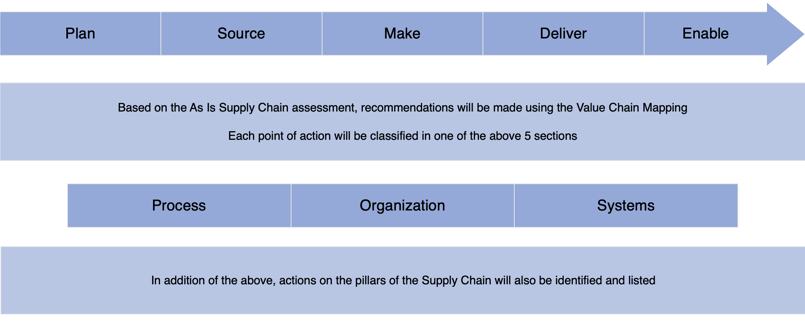How to assess a Supply Chain? Our experience in the Healthcare industry
Understand the As Is and identify gaps vs the To Be considering new business evolutions and the company's strategical objectives.
At Supply Chain Operations, we often start Supply Chain consulting journeys with a snapshot of the current operations. Throughout the assessment, all dimensions interacting and influencing the Supply Chain are discussed from product portfolio to last mile distribution. The entire Operations are explored under the prisme of the company's objective or current identified pain points. Focus is given during the journey on dimensions that are important for the business either because they were identified right from the beginning or because they simply pop out while exploring the current situation. Our expertise lies in the Life Sciences Industry. The approach described in this article has proven to be very efficient for assessing Pharma Supply Chain but can me slightly remodelled to fit any business.

At the end of the Supply Chain assessment, a report is usually shared with the different stakeholders:
- The Supply Chain team
- Directly or indirectly other departments involved/impacted by Supply Chain
- The Management
This article is organized with four key questions to help you understand the process, feel free to click on the relevant question for you or scroll down to read the full article.
What are the benefits of performing such an assessment?
What are the dimensions covered through the Supply Chain assessment?
At the end, what are usually the delivrables?
What are the benefits of performing such an assessment?
With experience we have learnt that performing a Supply Chain As Is assessment is highly effective to identify gaps vs a strategy/business evolutions/target/ambitions/etc. Bringing an external eye is extremely valuable in order to move away from any politics and to allow the organisation to take a step back. As Supply Chain manager/directors we are often carried out by the daily business, an external view truly helps to understand the bigger picture and reposition the current organisation in its context. At the end of the assessment, recommendations are established both on short term "low hanging fruits" actions and longer term - deeper change evolutions.
What are the dimensions covered through the Supply Chain assessment?
-
Products portfolio and markets
The As Is Supply Chain assessment starts with a review of the current and future product portfolio. Markets and geographies are also explored to understand the key drivers of the overall business. Understanding the future evolutions of business is also a key consideration of the analysis. Often a Pareto allows to identify quickly where the biggest stakes are and to focus on the highest impact elements.
-
Supply Chain setup and network
The journey continues with the global understanding of the Supply Chain. A mapping of internal and external operations is usually created. This exercise helps also to gain a first understanding of all the actors and the pain points / challenges across the organization. Quality and Regulatory framework are also introduced at this stage to set the scene. -
Sustainability
How mature is the organization in term of Sustainability ? How is the Supply Chain department/function contributing or not yet to the overall ambition? Those are the questions we aim at evaluating to understand how sustainability is important and the required efforts forward. -
Demand Planning
As Supply Chainers we all know that everything starts from the Demand. As such, we take time to understand the current process in place and its quality/accuracy through metrics. -
Supply Planning
Naturally, after reviewing the Demand processes we move to Supply planning. Understanding its maturity, the tools and its performance. Often this leads to introductory discussions on the mappings of all actors contributing to the end-to-end Value Chain. In the Pharma industry, we often explore models with many outsourced operations brining interesting challenged in the game. -
Inventory Management
Details on the current inventory level and policies in place are shared, sometime a deeper look is required by analysing data provided. For each domain of the assessment, the level of depth of the study is discussed amongst the team to identify how deep to go and where to stop. -
S&OP
Leveraging the learnings on demand and supply planning, the S&OP process is explored. The maturity/formalization of the process is particularly of interest. Here understanding the perceptions of all the relevant stakeholder is key to gain an in-depth understanding of the As Is. -
Sourcing
From strategy to processes around sourcing, we explore the current operations. Here risk assessment is often required to identify critical elements. The question of the overall Supply Chain resilience is often adresses through this section. -
External partners
Being CRO, CTO, CMO, CDMO, CPO or whatever external providers, it is of upmost importance to understand the company's network of partners and responsibilities. Quality evaluations is also extremely valuable and delivers important information about those key partners. At SCO, we drive more assessments with external partners than internalization but the same approach applies for internal operations. -
Capacity
It is often crucial to understand current and future capacity especially in the context of scaling up operations. Under this chapter, we also explore process reliability and design for future frowth. -
Logistics
What are the different operations handled by the logistics? What are the logistics performance? What are the Incoterm agreement for upstream and downstream flows as well as temperature controlled solutions in place? Depending on the size of the organization, the overall network around the globe and responsibilites are studied. -
Customer service
Leveraging internal and external data, a lot of insights can be gained through customer service. KPIs in place provide meaningful information as well as processes such as complaints, deviations or recalls. -
Finance
For this stream, focus is usually given on COGS analysis. Key financial drivers are discussed with both the Supply Chain team and the Finance department. In our experience, the maturity on COGS is very often a good indicator of the overall Supply Chain maturity. -
Quality
Throughout each process, quality systems and metrics are captured. In addition, we often suggest a dedicated workshop on Quality to understand the company's system and the Supply Chain maturity vs the internal and external requirements. -
Regulatory considerations
Understanding the context and the framework in place is key and must be considered in the overall Supply Chain setup and Operations. Our team has the seniority to understand and bring to the table high level Regulatory considerations but SME are sometimes required for in-depth analysis. -
Organization
Following the global assessment, the organization can be evaluated in regards of the operations, the projects and the priorities.
How long does it last?
A Supply Chain assessment usually takes between one to six weeks. This highly depends on the organization size but also on the availability of the teams, the documents available and the underlying objective of the exercise.
It is a great first step to understand where the company stands before starting to take concrete improvements actions.
At the end, what are usually the delivrables?
Leveraging all the data and information collected, a picture of the current Supply Chain is compiled. A mapping of key processes and stakeholders is established as well as a SWOT analysis. In addition, we believe it is important to have a risk based approach highlighting key risks identified throughout the assessment.
At Supply Chain Operations, we usually classify the learning using the following matrix:

Related to the objectives set beforehand, the gaps are listed and prioritized between "low hanging fruits" actions to implement with quick results. A list of the long term efforts is established highlighting the path to close the gaps and/or meet the targets.
So, are you curious to explore the services of Supply Chain Operations and discover how we can help you? Don't hesitate to set up a meeting with our team and let's take the first step together!
Set a meeting to discuss with our team:



